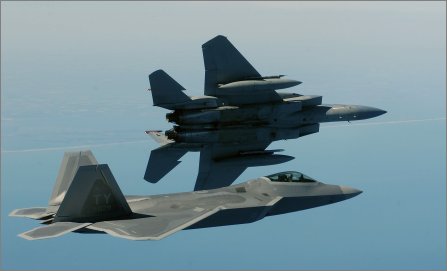USAF forced to sacrifice one quarter of its fighter aircraft to preserve Raptor and Joint Strike Fighter acquisition plans
The Bush administration’s fiscal year 2007 budget request, as expected, left the US Air Force’s prized new fighter programmes – the Lockheed Martin F-22A Raptor and F-35A Joint Strike Fighter (JSF) – intact, but that restraint packed a surprising cost.
One-quarter of the US Air Force’s existing fighter inventory will be phased out as the so-called fifth-generation fleet is ushered into service over the next two decades, the service has announced. A 25% reduction amounts to the elimination of roughly 800 current fighters. The air force is hoping the advanced capabilities of the F-22, F-35 and upgrades to a small core fleet of existing fighters will be enough to offset the loss in numbers.
|
F-22s and F-15s could be at the heart of the US Air Force of the future, with the F-117 and U-2 to be retired |
The reductions appear to preserve current plans to buy 183 F-22s and 1,763 of the JSF programme’s F-35A conventional take-off and landing variant. Previously, top air force officials hinted the number of F-35As would be reduced, but the JSF Joint Programme Office says it has received no direction to adjust today’s programme of record.
To initiate the fighter phase-out plan, the air force has proposed as part of the FY2007 budget request to retire the 55-aircraft fleet of Lockheed F-117A Nighthawk stealth fighters. The air force also plans soon to retire a small number of the Fairchild O/A-10 Thunderbolt IIs that are excluded from a re-engining and re-winging upgrade programme.
In the long term, the air force’s strategy will require tough decisions to determine its mix of Boeing F-15C/D Eagles, F-15E Strike Eagles and Lockheed Martin F-16 Falcons. The equation may be complicated by encroaching service-life issues.
The F-16s were built to be flown for 8,000 flight hours, but many need a structural improvement called Falcon Star to reach that milestone. The F-15 is cleared for 18,000 flight hours.
The air force had always planned to upgrade and maintain around 170 F-15s through 2025. Planned improvements include the installation of a new active electronically scanned array (AESA) radar, which is expected to enter competition early in FY07, as well as integrating a new digital radar-warning receiver. The Air National Guard is upgrading 48 F-15C fighters over the next six years with a new AESA radar, the Raytheon APG-63(V)3.
That combination of about 225 F-15s, as well as a total of 1,946 F-22s and F-35s, would appear to form the core of a proposed new USAF force structure numbering no more than 2,200 aircraft.
However, the air force is also proposing the early phase-out of large numbers of other aircraft, such as the full Lockheed U-2 fleet and 38 Boeing B-52s. These actions are expected to prompt a backlash in Congress, where lawmakers traditionally defend the aircraft stationed at local bases. The air force says Congress is preventing the service from retiring about 800 aircraft ranging from ageing Boeing KC-135E tankers, to Lockheed C-130E transports.
Last year, Congress overturned several budget proposals that would have terminated major programmes, including the Lockheed C-130J multi-year procurement. Although no major programmes are threatened with termination, there are already signs that key lawmakers could fight the Pentagon’s proposals for the early phase-out of some aircraft.
Last year, for example, Representative Duncan Hunter, chairman of the House Armed Services Committee, suggested the USAF’s force structure was already too low and argued that military planners should think about buying the Block 60 F-16s developed for the United Arab Emirates and the most recent version of the F-15E purchased by Singapore.
To blunt this opposition, the air force says the smaller but more capable fighter force will be sufficient. Moreover, US airpower will be bolstered in the short term by the newly launched next-generation long-range strike programme, which seeks to accelerate the deployment of a new bomber from 2037 to 2018.
The air force is looking at a wide mix of options, including unmanned and manned long-range jets, plus ballistic missiles tipped with conventional warheads or hypersonic glide vehicles.
Also included in the FY07 budget proposal:
- Roughly $8 billion is earmarked in the USAF budget plan for restarting the tanker acquisition programme over the next six years, says budget director Maj Gen Frank Faykes. That is enough funding to conduct the competition, launch production and perhaps secure the first handful of deliveries. Last year, the air force’s plan was to buy the first four tankers in FY10 and eight more in FY11, ramping up to 15 aircraft a year by FY14.
- The USAF is leading a one-year joint study on replacing electronic-warfare capabilities lost in the FY07 budget proposal, which would terminate the Joint Unmanned Combat Air Systems programme and the B-52 Stand-off Jammer System, says Lt Gen Stephen Wood, deputy chief of staff for plans and programmes.
- USAF orders for Boeing C-17 Globemaster IIIs would cease with the final 12 purchased in FY07, although this decision is likely to face opposition in Congress. Meanwhile, the air force dedicated $1.4 billion over the next six years to launch a Light Cargo Aircraft programme in partnership with the US Army’s Future Cargo Aircraft procurement. Another $395 million is provided to start recapitalising the combat rescue tanker fleet for special operations.
- The air force budget proposal includes $752 million to buy six Northrop Grumman RQ-4A Global Hawk unmanned air vehicles and three ground stations in FY07. The budget would also buy 24 MQ-1 Predators and two test models of the MQ-9 Predator B for a total of $349 million.
STEPHEN TRIMBLE / WASHINGTON DC
Source: Flight International
























